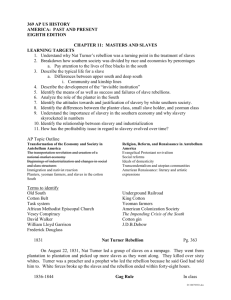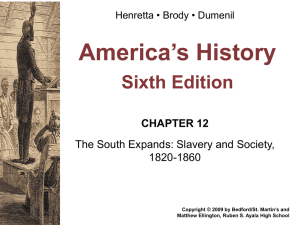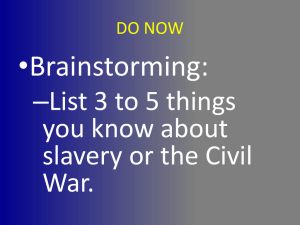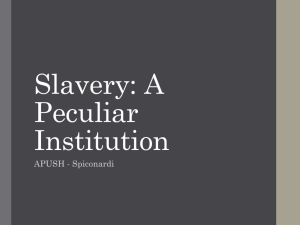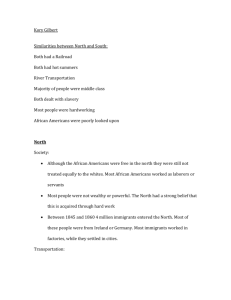Cotton, Slavery, and the Old South
advertisement
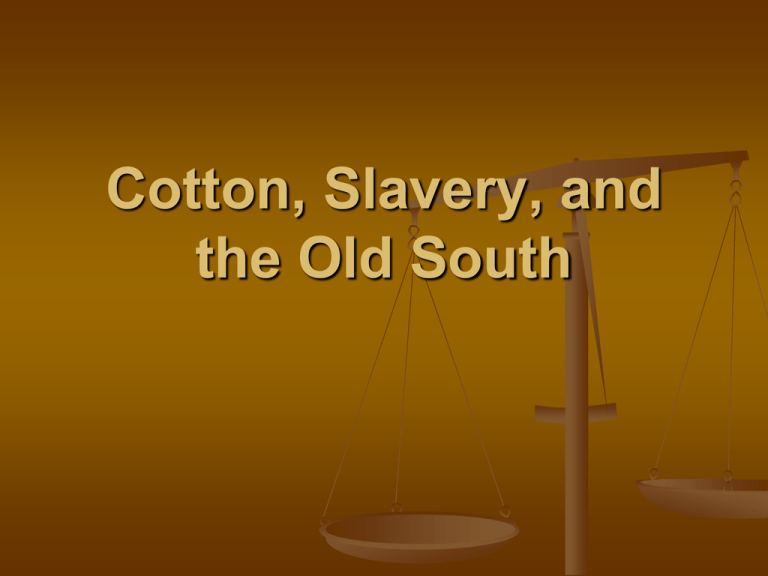
Cotton, Slavery, and the Old South The South, like the North, experienced dramatic growth in the middle yrs. of the 19th cent. Sugar Rice Tobacco Cotton The South experienced a much less fundamental transformation in these yrs. than did the North; “The South grew, but it didn’t develop.” The Cotton Economy Shift of economic power from the “upper South” to the “lower South.” Growing dominance of cotton in the southern economy The Rise of King Cotton Upper South – tobacco – VA, MD, & NC; many were switching to wheat The Cotton Economy (cont) Southern regions of the coastal South – SC, GA, & parts of FL – cultivation of rice Gulf Coast – sugar The Cotton Economy (cont) Short-staple cotton Demands for cotton increased rapidly w/the growth of the textile industry in Britain & in the 1820s & 1830s in New England “Cotton is king!” Production dominated the “lower South” or the “Deep South” Southern Trade and Industry Other forms of economic activity developed slowly in the South Industry remained an insignificant force in comparison w/the agricultural economy South had a very rudimentary financial system Southern Trade and Industry (cont) South’s inadequate transportation system; the principal mode of transportation was water Becoming more & more dependent on the manufacturers, merchants, & professionals of the North Southern Trade and Industry (cont) James B. D. DeBow DeBow’s Review Magazine advocating southern commercial & agricultural expansion & economic independence from the North (1846 – 1880) Sources of Southern Difference Why did it remain so different from the North? Great profitability of the region’s agricultural system; wealthy southerners had little left for other investments Sources of Southern Difference (cont) A set of values distinctive to the South that discouraged the growth of cities & industry – traditional values of chivalry, leisure, & elegance “Cavaliers” – people happily free from the base, acquisitive instincts of northerners; reality of southern society was rather different The Planter Class Only a small minority of southern whites owned slaves; planter aristocracy exercised power & influence far in excess of their numbers Planters were, in many respects, just as much competitive capitalists as the industrialists of the North The Planter Class (cont) Elaborate code of chivalry – defending their honor, often through duels; those that didn’t become planters often gravitated toward the military The “Southern Lady” Generally centered in the home; less frequently than Northerners did they engage in public activities or income-producing employment Cult of honor – “defense” of women; reality – men were even more dominant & women even more subordinate in southern culture than they were in the North Vast majority lived on farms, isolated from people The “Southern Lady” (cont) Had less access to education than their Northern counterparts Birth rate remained nearly 20% higher than the nation as a whole; slave labor system’s impact on white women Many women defended the special virtues of the southern way of life The Plain Folk The typical white southerner was not a great planter & slaveholder but a modest yeoman farmer Southern educational system provided poor whites w/few opportunities to learn The subordination of the plain folk to the planter class – Why did the plain folk not oppose the aristocratic social system in which they shared so little? Southern highlanders, “hill country,” “backcountry” areas cut off from the more commercial world of the plantation system. Frequently expressed animosity toward the planter aristocracy. Non-slaveholders outnumbered slave-holders. Other southerners who shared almost not at all in the plantation economy & yet continued to accept its premises. The “Peculiar Institution” Slavery isolated the South from the rest of Am. Society African Americans under slavery began to develop a society & culture of their own The “Peculiar Institution” Slavery was regulated in detail by law – slave codes – forbade slaves to hold property, to be out after dark, to carry firearms, to congregate w/other slaves except at church. Contained no provisions to legalize marriage Enforcement of these laws was spotty & uneven The “Peculiar Institution” Many slaves preferred to work on large plantations rather than small Task system vs. gang system of labor Slavery in the Cities Masters often hired out slaves for such tasks as mining, lumbering, docks, & construction sites Segregation was a means of social control Free African Americans Unemployment Virtual enslavement Urban areas Racism prevalent Slave Resistance The dominant response of African Americans to slavery was a complex one: a combination of adaptation & resistance “Sambo” vs. Revolt Slave Resistance Actual slave revolts were extremely rare 1800 – Gabriel Prosser 1822 – Denmark Vessey 1831 – Nat Turner, led a band of slaves armed w/guns & axes from house to house in Southampton County, VA. Killed 60 people before being overpowered by st. & federal troops. St. laws governing slavery became even more rigid. The Culture of Slavery Developing own, separate culture Slave religion – African Americans throughout the South developed their own version of Christianity Religion was more emotional; emphasized the dream of freedom & deliverance The Slave Family The other crucial institution of African American culture in the South Extended kinship networks were strong & important Paternalism became a vital instrument of white control

